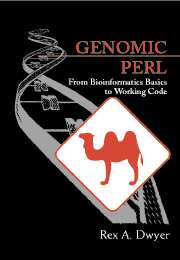Book contents
- Frontmatter
- Contents
- Preface
- Acknowledgments
- 1 The Central Dogma
- 2 RNA Secondary Structure
- 3 Comparing DNA Sequences
- 4 Predicting Species: Statistical Models
- 5 Substitution Matrices for Amino Acids
- 6 Sequence Databases
- 7 Local Alignment and the BLAST Heuristic
- 8 Statistics of BLAST Database Searches
- 9 Multiple Sequence Alignment I
- 10 Multiple Sequence Alignment II
- 11 Phylogeny Reconstruction
- 12 Protein Motifs and PROSITE
- 13 Fragment Assembly
- 14 Coding Sequence Prediction with Dicodons
- 15 Satellite Identification
- 16 Restriction Mapping
- 17 Rearranging Genomes: Gates and Hurdles
- A Drawing RNA Cloverleaves
- B Space-Saving Strategies for Alignment
- C A Data Structure for Disjoint Sets
- D Suggestions for Further Reading
- Bibliography
- Index
2 - RNA Secondary Structure
Published online by Cambridge University Press: 05 June 2012
- Frontmatter
- Contents
- Preface
- Acknowledgments
- 1 The Central Dogma
- 2 RNA Secondary Structure
- 3 Comparing DNA Sequences
- 4 Predicting Species: Statistical Models
- 5 Substitution Matrices for Amino Acids
- 6 Sequence Databases
- 7 Local Alignment and the BLAST Heuristic
- 8 Statistics of BLAST Database Searches
- 9 Multiple Sequence Alignment I
- 10 Multiple Sequence Alignment II
- 11 Phylogeny Reconstruction
- 12 Protein Motifs and PROSITE
- 13 Fragment Assembly
- 14 Coding Sequence Prediction with Dicodons
- 15 Satellite Identification
- 16 Restriction Mapping
- 17 Rearranging Genomes: Gates and Hurdles
- A Drawing RNA Cloverleaves
- B Space-Saving Strategies for Alignment
- C A Data Structure for Disjoint Sets
- D Suggestions for Further Reading
- Bibliography
- Index
Summary
In the previous chapter, we concentrated on the flow of information from DNA to RNA to protein sequence and emphasized RNA's role as a “messenger” carrying copies of DNA's protein recipes to the ribosome for production. In this function, RNA's role is similar to the paper in a photocopy machine: though perhaps not always flat, it must be flattened out and dealt with in a linear fashion when used. RNA also plays catalytic roles in which it more resembles the paper used in origami: the shape into which it is folded is what matters most.
Messenger and Catalytic RNA
RNA is sufficiently versatile as a catalyst that some scientists postulate that the origins of life lie in an “RNA world” preceding both DNA and proteins. Other scientists have invented new RNA catalysts in the laboratory by experimentation with random RNA sequences. Important categories of catalytic RNAs in higher organisms include the following.
transfer RNA (tRNA). These RNAs, typically around 85 bases long, are crucial in the translation process. tRNAs assume a shape approximating the letter “L”. In the presence of a ribosome, the three-base anticodon at the top of the L is able to bind to a single codon in the messenger RNA. The shape of the base of the L allows it to bind to a single molecule of a particular one of the 20 amino acids. During translation, tRNAs collect their respective amino acids from the cytoplasm with the assistance of enzymes called aminoacyl-tRNA synthetases. When a tRNA approaches a ribosome poised over the appropriate codon on the mRNA, the tRNA binds to the codon and the ribosome. Next, the amino acid is released from the tRNA and attaches to the growing protein. Finally, the tRNA is released from the mRNA and departs in search of another amino acid molecule.
Information
- Type
- Chapter
- Information
- Genomic PerlFrom Bioinformatics Basics to Working Code, pp. 16 - 29Publisher: Cambridge University PressPrint publication year: 2002
